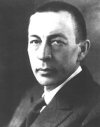
Sergey Rachmaninov
Sergey Rachmaninov lived the last 26 years of his life in the United States, having fled Russia after the revolution of 1917. His music, however, remain firmly rooted in the Russian tradition. He was, in fact, the last of the great Romantic Russian composers, his music richly orchestrated, his melodies swellingly emotional, his harmonies dense but traditional. Given the almost 19
th century style of his music, it comes as a surprise to learn that he died in 1943.
In his day Rachmaninov was most famous as a pianist, possible the most formidable pianist of his era. His huge hands, which could span from middle C to high G, became famous, and his performances became the stuff of legend, described as “
awe-inspiring”, “
cosmic” and “
overwhelming”.
Today, however, he is best-known as a composer of rich, melancholic and bitter-sweet music. His final three works, the
Variations on a Theme of Paganini Op.43, the
Third Symphony Op.44 and the
Symphonic Dances Op.45 share a common theme. All were written in the United States in the late 1930's. Rachmaninov was nearing the end of his life, in exile from his homeland. The world was on the brink of war, and when the
Symphonic Dances were completed in 1940, France had fallen to the Germans.
These three last works are more spartan than their predecessors, less lush in their orchestrations, more direct and menacing in their tone. And all three quote that Rachmaninovian obsession, the
Dies Irae, the “Day of Wrath” theme from the Latin Requiem Mass, which had also been used by Saint-Saens in
Danse Macabre and Berlioz in
Symphonie Fantastique. While Rachmaninov never talked about death, it is clear that this is the theme of the
Symphonic Dances.
Rachmaninov wrote no more music after his
Symphonic Dances. It was, he said, his “final flicker” and today many regard it as his finest music, perhaps even comprehensive enough to be his Fourth Symphony.
Originally titled
Fantastic Dances in three parts Noon, Twilight and Midnight the
Symphonic Dances is made up of three movements all in dance style. In fact, Rachmaninov had intended for them to be choreographed.

The first movement has an energetic, martial opening theme that melts into the most beautiful saxophone melody in the central section, a melody soon taken up and passionately expanded by the strings. This is the Rachmaninov of old, but not for long. The movement ends with a return of the threatening military theme.

The second movement is a waltz, but more in the style of Ravel's
La Valse than anything by Johann Strauss. It starts out hesitant and awkward, but builds into a lovely, lilting and sad tune. As it progresses it whirls and twirls, slowly decaying and becoming more and more sinister, almost an anti-waltz, perhaps depicting the decay of society.

The final movement is the crux of the piece, the finale of Rachmaninov's last testament. It begins with short, seemingly separate snatches of musical themes, until all these hints coalesce into the famous
Dies Irae. A quiet but still restless, searching interlude leads into a explosive, overwhelming statement of
Dies Irae blasting forth on trumpets and tympani. But just when death has won the day, Rachmaninov quotes his own
Vespers symbolising the resurection of Christ.
Two piano version
Martha Argerich
Alexandre Rabinovitch
[an error occurred while processing this directive]
|
Rachmaninov wrote a two piano version of
Symphonic Dances at the same time that he was orchestrating it. This piano version displays Rachmaninov's virtuoso keyboard skills and this recording is a razor-sharp show-stopper.
But its a remarkable orchestral recording we review today. Eiji Oue is a Japanese conductor, previously almost unknown, who took the Minnesota Orchestra to great heights during his tenure. His speciality is orchestral showpieces, and he delivers in bucket-loads. This recording includes the
Symphonic Dances, the famous
Vocalise (a wordless song taken from Rachmaninov's opus 34, here set for orchestra) and the
Etudes-Tableau. Rachmaninov's best-known music, performed lavishly but without sentimentality, meltingly smooth when required, and devastatingly powerful at the climaxes.
To top it off, the recording by the small San Francisco studio Reference Records sets a new standard for sound quality. This is easily a CD to demonstrate or test the capabilities of any audio system. Crystal clear, huge dynamic range, and an orchestral realism unmatched in recent times. Every instrument can be placed and heard in detail, every nuance discerned. The percussion will make you jump.
Rarely do we award the 5 gramophone rating, but this is standing-ovation stuff!
Please support Good-Music-Guide.com
by purchasing this CD using this link.

Track Listing
Sergey Rachmaninov
Orchestral Works
Minnesota Orchestra
Eiji Oue
Symphonic Dances
- Non Allegro
- Andante Con Moto (Tempo Di Valse)
- Lento Assai
- Vocalise
Etudes-Tableaux
- The Sea And The Seagulls
- The Fair
- Funeral March
- Little Red Riding Hood And The Wolf
- March